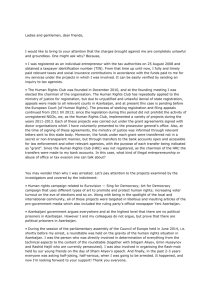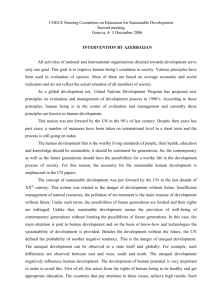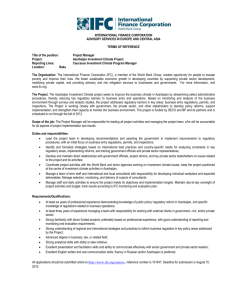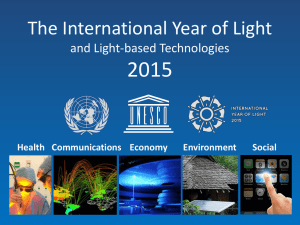Workshop: Building future bridges: elimination of the digital
advertisement
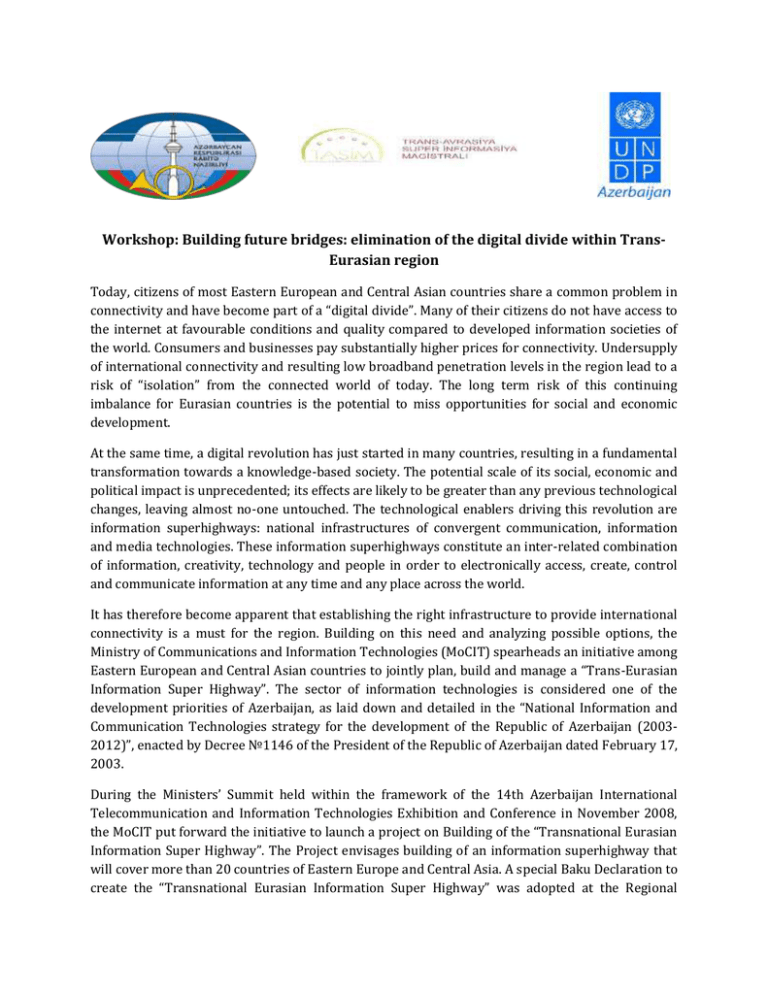
Workshop: Building future bridges: elimination of the digital divide within TransEurasian region Today, citizens of most Eastern European and Central Asian countries share a common problem in connectivity and have become part of a “digital divide”. Many of their citizens do not have access to the internet at favourable conditions and quality compared to developed information societies of the world. Consumers and businesses pay substantially higher prices for connectivity. Undersupply of international connectivity and resulting low broadband penetration levels in the region lead to a risk of “isolation” from the connected world of today. The long term risk of this continuing imbalance for Eurasian countries is the potential to miss opportunities for social and economic development. At the same time, a digital revolution has just started in many countries, resulting in a fundamental transformation towards a knowledge-based society. The potential scale of its social, economic and political impact is unprecedented; its effects are likely to be greater than any previous technological changes, leaving almost no-one untouched. The technological enablers driving this revolution are information superhighways: national infrastructures of convergent communication, information and media technologies. These information superhighways constitute an inter-related combination of information, creativity, technology and people in order to electronically access, create, control and communicate information at any time and any place across the world. It has therefore become apparent that establishing the right infrastructure to provide international connectivity is a must for the region. Building on this need and analyzing possible options, the Ministry of Communications and Information Technologies (MoCIT) spearheads an initiative among Eastern European and Central Asian countries to jointly plan, build and manage a “Trans-Eurasian Information Super Highway”. The sector of information technologies is considered one of the development priorities of Azerbaijan, as laid down and detailed in the “National Information and Communication Technologies strategy for the development of the Republic of Azerbaijan (20032012)”, enacted by Decree №1146 of the President of the Republic of Azerbaijan dated February 17, 2003. During the Ministers’ Summit held within the framework of the 14th Azerbaijan International Telecommunication and Information Technologies Exhibition and Conference in November 2008, the MoCIT put forward the initiative to launch a project on Building of the “Transnational Eurasian Information Super Highway”. The Project envisages building of an information superhighway that will cover more than 20 countries of Eastern Europe and Central Asia. A special Baku Declaration to create the “Transnational Eurasian Information Super Highway” was adopted at the Regional Ministerial Meeting on the Transnational Eurasian Super Information Highway held on November 11, 2008 in Baku. It was acknowledged and endorsed by the representatives of Afghanistan, Azerbaijan, Belarus, Egypt, Estonia, Georgia, India, Iran, Jordan, Kazakhstan, Lithuania, Moldova, Russia, Slovenia, Ukraine and the United States, as well as by the executives of such international entities as the Global Alliance on Internet Development (GAID), the Regional Communication Commonwealth (RCC), the Trans Asia-Europe Network (TAE) and the United Nations Department for Economic and Social Affairs. There are currently two information superhighways in the world. The first one covers Western Europe and North America, and the second one covers Japan, Korea, China, Singapore, New Zealand, Malaysia and Australia. Azerbaijan’s initiative on building the third information superhighway has received great interest and support from other states in the region. On December 21, 2009 the UN General Assembly unanimously adopted resolution (A/Res/64/186) entitled “Building connectivity through Trans-Eurasian Information Super Highway” calls for the implementation of the “Trans-Eurasian Information Super Highway” project. The project aims to lay transnational fibre-optic line covering the countries of Eurasia from Western Europe to Eastern Asia. The line will combine the major centers of information exchange in Europe and Asia. The transit line will stretch through China, Kazakhstan, Azerbaijan, Georgia and Turkey to Germany, likewise Reserve North transit line will pass through the territory of Russia, Ukraine and Poland. The resolution, supported by some of 30 countries also recognizes the coordinating role of the Government of the Republic of Azerbaijan in advancing the Project. Furthermore, on December 21, 2012 UN General Assembly adopted second resolution (A/Res/67/194) which renewed political support for the “Trans-Eurasian Information Super Highway” project, initiated by the Government of Azerbaijan. The resolution enjoyed unanimous support of the UN Member states and was cosponsored by Afghanistan, Australia, Belarus, Canada, China, Georgia, India, Iraq, Israel, Japan, Kazakhstan, Kuwait, Lebanon, the Republic of Korea, the Republic of Moldova, Morocco, New Zealand, Pakistan, Russian Federation, Sri Lanka, Tanzania, Turkey, Ukraine, Uzbekistan, the U.S. just to name a few. The Project primarily envisages the establishment of the Eurasian Connectivity Alliance (EurACA) for making contribution to the development of telecommunication transit routes in the region and improving the coordination between the governments, private sector, civil society and international development institutions. Establishment of EurACA will lead to better coordination between the governments, private sector, civil society and international development institutions. Accordingly the establishment of the EurACA will play a pivotal role in improving relations between the government, private sector, civil society and international development organizations for the development of telecommunications transit routes in the region. Consequently, the EurACA will combine the major centers of information exchange in European and Asian continents. Hence the EurACA will essentially contribute to create open information society in the region, to increase the speed of Internet connection and the development of Internet services, likewise the component will lead to economic development, diversification of the economy and increased competition. So, we can say that the solution of digital divide problem will help to start “active period” and social and economic development will be achieved in the region, Internet access costs will become cheaper by which an easy access to the internet will be achieved. The achievements of this activity are expected to be resulted in the development of interregional traffic, regional and global trade relations. In this regard, the establishment of the Trans-Eurasian Information Super Highway (TASIM) project and Eurasian Connectivity Alliance should be considered as a means of development of Eurasian countries.
